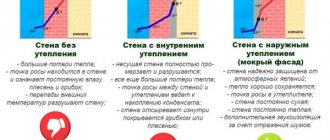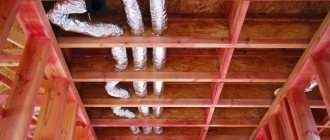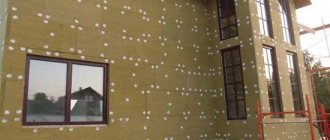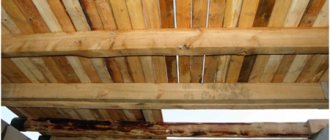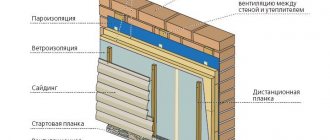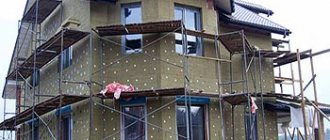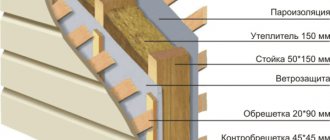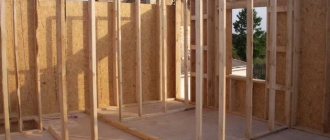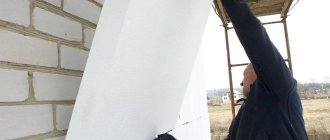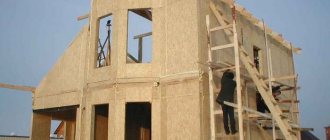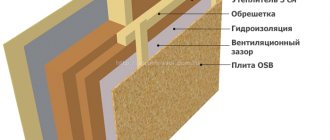Frame houses have become popular because of their low cost, and the construction time is minimal. Basically, those who decide to build such a house for themselves have a dilemma with the choice of thermal insulation. Based on a combination of factors, insulating a frame house with mineral wool can be called the optimal solution. Mineral wool retains heat quite well, you can install it yourself, it is environmentally friendly and, most importantly, does not burn. Also read: “Choosing insulation for a frame house.”
How to properly insulate a frame house with mineral wool with your own hands
Everyone dreams of having their own country house in the Moscow region, but not many people think that a private house is far from an apartment and requires much more attention, especially if they do not build it themselves, but buy it ready-made. Heating a private house in the cold season is a difficult and expensive task, but you can significantly reduce costs by insulating the walls of a frame house yourself.
Mineral wool is an excellent popular modern insulation material
There are a lot of options on how to make your home warmer, but most often various types of mineral wool are used as insulation. Using mineral wool, you can carry out all the work yourself.
Insulation of a frame structure house is different in that the insulation is located in the center of the wall between the frame sheathing. This is how the frame structure is insulated during the construction of a newly built house. If you want to perform additional insulation of an existing building, then the insulation should be placed outside the walls of the house or inside.
Additional insulation of a frame house is carried out in two ways:
- Work on the external wall with subsequent finishing, for example, siding.
- Internal insulation.
External thermal insulation under siding
This is the most effective option, since the technology involves not only installing an insulating layer, but also updating the facade with materials that are not afraid of negative environmental factors and can easily withstand low temperatures. The siding is fixed on guides, which are used as a wooden beam or a metal frame.
Considering that modern mineral wool is produced in standard sizes in rolls or slabs, the guides for fastening the siding are filled in increments equal to the width of the mineral wool strip. Depending on the type of mineral wool and the walls of the structure, it is secured by shooting it with an industrial stapler or using special glue. Only mineral wool slabs are attached to glue, since they have a relatively dense structure and backing.
Note! In addition to the insulation itself, it is recommended to apply a steam and moisture-proof membrane to the walls of the house. It is mounted directly on the wall, and the insulation is already attached to it.
The last stage of external insulation is the installation of siding, the individual strips of which, with the help of locks, are assembled into a single surface, which has many advantages:
- Siding is immune to temperature changes.
- Not afraid of moisture.
- It does not require heavy structures for installation, as it is light in weight.
- Does not fade in the sun.
- It lasts a long time. Manufacturer's warranty for at least 15 years.
Internal thermal insulation
Insulation inside a house is much more difficult compared to outside. Not all materials can be used, as it is necessary to comply with fire safety and environmental standards. Mineral wool is a partially natural and environmentally friendly insulation material that is excellent for interior work.
The installation technology does not differ from the external one, however, the frame is sheathed not with siding, but with plasterboard or OSB panels (approximate strand boards). Thermal insulation of buildings from the inside has its disadvantages, the main of which are:
- Reducing room space.
- If steam and waterproofing are not installed correctly, the walls will begin to become damp, which will lead to the appearance of mold.
- The base of the wall warms up worse, since the heat from inside the house does not reach it, and accordingly a freezing effect appears. Sooner or later this will lead to the destruction of the supporting structure.
- It is possible that a dew point may form inside the insulation layer or directly on the wall due to impaired heat exchange.
How to insulate a frame with mineral wool
As mentioned above, a frame building can be insulated with mineral wool both outside and inside when performing additional insulation of an already built house. When building a house anew, the insulation in a frame structure is located in the middle, between the frame sheathing, and is not attached to the outer or inner surface of the wall.
Vapor barrier as an important component of an insulated structure
An important part of the “layer cake” with mineral wool is the implementation of a vapor barrier. This material is a film that prevents water vapor contained in the air from penetrating into the structure.
Membrane vapor barrier
Natural air humidity with improper insulation of frame walls and ceilings can greatly wet mineral wool. To make it clear how much, take a look at the following photo, which shows that water runs out from behind the removed film in a stream.
Improperly performed vapor barrier will completely “kill” the insulation
If you look closely, you can see black mold showing through. Why did this happen?
Vapor barrier films can be solid (double-sided) or membrane (one-sided). The first ones do not allow either water or air to pass through in two directions. These materials are good as a waterproofing barrier. Because of them, condensation and steam will form, which nevertheless penetrates into the insulation and will have nowhere to evaporate.
The second type of film allows moist air to pass through in one direction; the second side is a barrier that greatly reduces the passage of steam. Its meaning is that the structure continues to “breathe”, but at the same time gets less wet.
Layer-by-layer structure of a frame wall
Such films are placed on both sides of the insulation. You can see what a complete diagram of the walls of a frame house looks like in the diagram above. An internal vapor barrier is installed so that air can escape from the wall, but not vice versa. External - also does not prevent steam from escaping from the walls and protects the material from precipitation (if the external cladding is leaking) and wind - this material is very durable, multi-layered, which helps it cope with high mechanical loads.
Attention! Mineral wool suffers not only from moisture, the wind also destroys it, gradually blowing out particles.
Let's return to the photo with an incorrectly made vapor barrier. The vapor barrier film was installed on the wrong side and as a result, moisture from the room got inside, but there was nowhere for it to escape. Then it’s only a matter of time before the mineral wool gets wet through and stops fulfilling its intended purpose.
To avoid such mistakes, carefully read the film manufacturer’s instructions to avoid the wrong side during installation.
Membrane films do not completely stop steam - some of it still penetrates from the room, so on the back side it is necessary to provide a ventilation gap through which street air will move, as shown in the diagram below. It will involve evaporation in the movement, due to which the mineral wool will dry well without losing its properties.
Scheme of steam movement through an insulated roof
If the room being insulated has very high humidity (bathhouse, bathroom, sauna, kitchen), it is better not to use diffuse membranes, as they will not cope with such a load. These rooms must be sealed tightly to completely prevent steam from entering the walls.
Read our article about insulating a bathhouse from the inside.
In this case, double-sided vapor barriers are used. An excellent solution is foil materials on a polyethylene foam base. They themselves are a good insulator, which will increase the efficiency of thermal insulation as a whole.
Sealed vapor barrier in the bathroom of a frame house with penofol
Due to the fact that steam will not pass through the walls at all, it will begin to accumulate and condense in the room - the windows will “cry” first. This is fraught with the formation of a greenhouse effect and the proliferation of mold on surfaces. To prevent this from happening, good supply and exhaust ventilation is organized in the room - passive or forced, depending on the size and configuration of the room.
Forced ventilation in the bathroom
Scheme for insulating the walls of a frame house with mineral wool
Scheme of the wall of a frame house with mineral wool insulation.
The scheme of insulation of the walls of a frame building is similar to a pie consisting of separate layers. The basis of the cake is a heat insulator, in our case it is mineral or stone wool.
Pie of walls of an insulated frame house
The wall pie of an insulated frame house consists of the following layers:
- Interior finishing, which is performed using plasterboard, OSB boards or other similar material.
- Vapor barrier layer.
- Thermal insulation layer, mineral or basalt wool. For a frame house, three layers of standard 50 mm insulation are used.
- Waterproofing layer.
- Wind and noise protection.
- Exterior finishing: siding, lining, finishing slabs or any other finishing.
The insulation is located between the frame sheathing, to which the external and internal OSB boards are attached.
Facade insulation
If the house has already been built, but its insulation is not enough, you can use facade insulation or perform external wall insulation, which was already mentioned above. Guides made of wood or metal are placed on the façade in increments equal to the width of the insulation slabs - mineral wool. Then a hydro and vapor barrier is laid. Sheets of mineral wool are placed between the guides and secured with a stapler or glue.
The insulation from the outside is covered with waterproofing and external finishing of the facade. This finishing can be siding, lining or facade slabs.
Interior work or façade insulation
If facades are insulated, then it is necessary to install a ventilated facade. To do this, the profile, block house or other cladding is attached to additional profiles so that the ventilation gap is at least 5-6 cm.
Also, for external insulation, you will need new slopes, platbands, etc. This is due to the inevitable increase in wall thickness when insulating the facade with mineral wool.
Inside the room, the insulation layer can be covered with plasterboard or clapboard.
Ceiling insulation technology
In addition to the walls, to obtain maximum effect, it is necessary to insulate all surfaces of the room, that is, do not ignore the floor and ceiling
The insulation methods directly depend on the type of ceiling, straight or sloping according to the shape of the roof, but in any case it is most convenient to work before the roof is completely installed. If the ceiling is straight, then the heat-insulating material is laid inside so that its edges extend onto the upper plane of the walls. When working with mineral wool slabs, they must be laid in several layers, observing a checkerboard pattern, so that the joints of the lower layer are covered by the upper layers.
Scheme of ceiling thermal insulation using mineral wool
Waterproofing is laid directly on the roof, but a vapor barrier material is applied between the insulation and the ceiling lining in order to prevent moisture from penetrating from the inside and at the same time maintaining a breathable effect.
The ceiling, which follows the slope of the roof, is insulated using the same technology, only the sheathing with sheets of mineral wool is carried out with additional fastenings so that they do not move out. They are laid between the roof joists, also supplemented with a steam and waterproofing layer.
Attic roof insulation scheme
Main varieties
There are several types of mineral wool on the construction market. They differ in the type of feedstock, advantages and disadvantages.
Slag
Metallurgical waste is used as the basis for production. When exposed to high temperatures, the additives are fused and drawn into thin threads. This type is considered the cheapest among all subtypes of mineral wool, but has important disadvantages. Among them:
- The release of acids when wet, which destroy even metal products.
- Less effective thermal insulation.
- Limited service life.
Slag is a recyclable material that is often used in construction.
Glass wool
The material is made from the remains of the glass industry or raw materials from the glass composition (sand, borax, limestone and soda). The components are thoroughly mixed and fused. They are then made into small threads. The main properties of the material include:
- Slight hygroscopicity compared to slag.
- Resistance to chemical, mechanical and biological influences.
- Minor shrinkage.
- Resistant to heat up to 450°C without ignition.
Glass wool is a fibrous mineral thermal insulation material.
At the same time, glass wool fibers are the most brittle of all other types of mineral wool.
Basalt wool
Rocks, for example, bentonite clays or basalt, are used as raw materials for the production of insulation.
Some suppliers include urea resins in their composition. Moreover, all components are completely harmless to the body and the environment.
Basalt wool is a fairly popular type of material.
Basalt slabs are characterized by a low water absorption coefficient and are practically protected from shrinkage. The price of the material is higher than that of the 2 previous types, but this is justified by its operational advantages.
Stone
The main component of stone wool is rocks of volcanic origin. They are melted at a temperature of 1400-1500°C, and then sent to a special centrifuge with rotating elements that break the mass into fibers. These fibers are then mixed with binders and placed in a special chamber, where they settle and form a carpet-like surface.
Stone wool is one of the most reliable heat insulators.
The thermal conductivity of stone wool is 0.035-0.045 W/m. The plates absorb sound well, do not ignite when heated to 700°C, are durable and environmentally friendly. However, the material contains additives based on phenol-formaldehyde resins, so phenol may be released during the heating process.
Floor insulation technology
Thermal insulation of floors is no less important, since foundation concrete is a good conductor of moisture and dampness that it absorbs from the ground. A very important aspect when working with a floor is a high-quality waterproofing layer. As a rule, it is laid in a double layer, first on the foundation itself, and then an additional layer on the subfloor.
The floor in frame buildings is most often arranged along logs. When installing a floor above a cold basement, a superdiffusion membrane is laid on the floor sheathing along the rough sheathing. Logs are placed along it, between which there is insulation with a thickness of at least 150 mm. When laying insulation slabs in several layers, it is necessary to observe the spacing of the joints between the slabs.
A vapor barrier film is mounted on top of the insulation, which is attached to the joists with a stapler.
Then a subfloor made of boards, plywood or OSB is installed. After this, you can lay the finishing coating on a soft substrate.
Floor insulation scheme using mineral wool
Insulation of the floor in a frame house
For more details, see the article “Insulation of the floor in a frame house.”
Thickness of material for insulating a frame house
To insulate frame structures, regardless of the type of mineral wool used, the thickness of the layer of heat-insulating material must be calculated using special formulas, but be at least 15 cm.
At the same time, different types of insulation have different thermal conductivity and other indicators, as can be seen in the table below.
| Options | Glass wool | Stone wool | Slag |
| Thermal conductivity coefficient, W/(m*deg. C) | 0,037-0,041 | 0,032-0,048 | 0,046-0,048 |
| Vapor permeability coefficient, mg/(m*hour*Pa) | 0,6 | 0,3 | 0,6 |
| Density, kg/m³ | 11-130 | 30-100 | 75-200 |
| Moisture absorption,% | 0,5-1 | 2 | Up to 2 |
| Sound absorption | High | High | good |
The insulation thickness parameter for frame houses depends on the climatic conditions in the region where the building is located. You can focus on the following numbers:
- 150 – 200 mm of mineral insulation if your house is located in central Russia, for example, in the Moscow region, and has gas heating;
- 200 - 250 mm - the same, but in the case of heating with electricity;
- 200 - 250 mm in the wall, if you live in the north or Siberia and have gas;
- 250 – 300 mm, if you heat yourself with electricity while living in Siberia.
Mineral wool - concept and features
The word “mineral” indicates the origin of the heat insulator. It is made from natural ingredients: rocks, limestone, clay, basalt, dolomite. When they melt, fibrous material is formed, from which mineral insulation is made. There is only air between the fibers, due to which the wool has excellent heat and sound insulation characteristics.
Mineral wool has a trump card that other insulation materials cannot boast of: it is not afraid of deformation loads.
Insulating mineral wool is produced in the form of slabs and rolls. The peculiarity of slabs (mats) is that they are more rigid/dense and can keep their original shape. Rolls are suitable for floors, attic floors (they are horizontal) and for unloaded structures. Peculiarities:
- Strength from 0.08 to 0.06 kg/cm2. The difference depends on the type of heat insulator.
- Thermal conductivity coefficient is from 0.036 to 0.060 W/(m*K), depending on the density.
- Moisture absorption 6–30% when completely immersed in water.
- The density of mineral wool for wall insulation is from 35 to 100 kg/m3.
- Vapor permeability from 0.21 to 0.41 mg/(mchPa).
- Fire resistance is high. The material can withstand temperatures of 1000 degrees.
- Sound insulation from 0.7 to 0.9 Rw (dB).
- Thermal insulation material will last from 50 to 70 years.
Which insulation is better to choose for a frame house?
When choosing mineral wool insulation, they are guided by the density and, accordingly, thermal conductivity of the material, and its cost. As a rule, the better the insulation retains heat, the higher its cost. Therefore, everyone decides for themselves what type of mineral insulation to choose.
Stone or mineral wool
Mineral wool in rolls or basalt - stone wool in slabs, these are the main materials used in modern construction of frame structures. Basalt - stone wool has a denser crystalline structure, which allows it to retain heat well. In addition, basalt fibers make the heat-insulating material non-flammable and less susceptible to moisture.
| Basalt - stone wool | Mineral wool |
| A fragile material that can break during installation and form harmful dust that not only irritates the skin, but also settles in the lungs | Long soft fibers are very elastic and do not generate harmful dust |
| Practically does not absorb moisture, and even when wet, continues to retain its heat-insulating properties. | It quickly absorbs water and practically does not remove it from its structure, which is why mold and other fungal infections can appear on surfaces. |
| Formaldehyde is used in production | Safe acrylic is used to bind the fibers |
| High resistance to temperature and open flame | There is still a risk of the material catching fire, since acrylic is used for production. |
| Thermal insulation level is high | Thermal insulation level is high |
| Both materials can be successfully used for thermal insulation of rooms in a frame house | |
Insulation of a frame house with mineral wool or basalt slab
What material to choose for insulating a frame house? It can be understood from the above table of the main characteristics of basalt and mineral wool that, in principle, they are both well suited for performing insulation. Basalt wool will be better when insulating a house from the inside, since it has better vapor permeability.
Thermal insulation with mineral wool: step-by-step instructions
In most cases, mineral wool in the form of mats . Therefore, subsequent instructions will be based on working with this material.
Preparatory activities
The first thing you need to do is understand the structure of the insulation cake, calculate the material and prepare the surface for installation. It doesn’t matter which side to start the work from - outside or inside. Some people believe that it is more convenient to perform thermal insulation from the street side. However, weather factors must be taken into account.
The standard structure of a thermal insulation cake with the order of layers from the internal cladding to the facade of the house:
- Decorative finishing indoors.
- OSB board.
- Vapor barrier.
- Insulation layer.
- Windproof membrane.
- Lathing made of bars for arranging a ventilation gap.
- OSB board.
- External cladding.
The recommended pitch of frame beams is 580-590 mm. This range is optimal when using standard mineral wool mats 60 cm wide. According to the standards, the thickness of the insulation for temperate climates is 150 mm. To fill the space between the beams of 15 cm, it is advisable to use mineral wool of two sizes: 50 and 100 mm.
Surface preparation comes down to cleaning off dust, removing protruding nails and blowing in the cracks with foam between the frame elements. Before attaching the insulation, it is necessary to check the wooden structures for dampness, and dry the problem areas with a hair dryer.
Interior finishing: sequence of layers
First you need to prepare the base for laying the insulation. On the inside of the house, this role will be performed by a vapor barrier film and OSB boards .
Procedure:
- Roll out a roll of insulating material and cut it to the size of the walls of the house.
- Secure the vapor barrier sheets one by one to the vertical posts of the frame using a stapler. Installation rules: the insulating strips are directed perpendicular to the wooden beams, the minimum overlap is 10 cm.
- Check the tightness of the protective layer.
- Cut OSB boards with a jigsaw.
- Secure the panels to the frame, covering the vapor barrier film.
In the future, OSB boards will serve as the basis for applying the final finishing to the walls.
Rules for installing insulation
An important advantage of using mineral wool or wood fiber insulation is the ease of installation with your own hands. Both heat insulators are quite elastic, so they do not require additional fixation. The slabs are inserted between the frame posts and are held in place due to the slight difference in size.
To ensure that the thermal insulation layer does not lose its effectiveness over time, it is necessary to follow certain rules for its installation:
- Laying is done in two layers, the slabs are placed in a checkerboard pattern. The second row of mineral wool should overlap the joining seams of the first in the middle. This technique prevents the appearance of “cold bridges” that contribute to the accumulation of condensation and dampness.
- Insulation boards need protection from strong winds and precipitation. By analogy with the internal wall, the heat insulator is sheathed with a special hydro-windproof membrane.
Useful: Methods for forming and covering warm corners in a frame house
The film insulation is fixed with a stapler. For more reliable fastening, you can use a counter-latching system.
External wall cladding
The beams attached on top of the wind barrier create the necessary air gap between the thermal insulation material and the exterior finish. Further insulation of the facade depends on the material of the finishing cladding.
Under the block house and siding of various types, moisture-resistant OSB boards are nailed onto the sheathing, to which guide bars are attached. Artificial, natural stone or facade tiles are laid directly on oriented strand boards.
Thermal insulation of a house roof
High-quality roof insulation is of great importance in preserving heat. Thoughtful and well-executed thermal insulation of the roof of a frame house saves 25-30% of thermal energy. A popular insulation option is placing mineral wool between the rafters. The roofing pie must be supplemented with a vapor barrier film and a diffusion membrane.
We will describe sequentially how to properly insulate a roof :
- Stretch a water-repellent diffusion film along the outer end of the rafters. Secure the membrane with a counter-batten.
- Lay insulation on the inside of the rafter system. Thermal insulation is placed in two layers 100 mm thick, the installation pattern is a checkerboard layout.
- Cover the mineral wool with a vapor barrier film, observing the horizontal laying of the vapor barrier in the direction from bottom to top. The overlap of film insulation is 5-10 cm.
- Cover the ceiling with OSB, plasterboard, plywood or clapboard. The external finishing of the roof is done using counter lathing. Sheathing bars are nailed onto the slats, creating a ventilation gap. OSB boards or directly roofing material (slate, corrugated sheeting, metal or flexible tiles) are attached to the top.
Insulation of the first floor floor
A lot of heat also escapes through the foundation of the house - about 15-20% of heat costs fall on the floor. As an option, you can organize water underfloor heating. However, it is easier and cheaper to insulate the base with mineral wool.
Work progress:
- Cover the subfloor with roll waterproofing, maintaining an overlap of 5 cm.
- Fasten the canvases together with reinforcing tape, running it along the joining lines.
- Install a log system made of boards on top of the waterproofing.
- Cut out the insulation for the cells in the joists. The size of the heat insulator should exceed the distance between the boards by 1-2 cm - this gap is necessary for tight joining and eliminating gaps. The thickness of the insulation is at least 200 mm.
- Cover with a vapor barrier film, and lay plywood or a finished plank floor on top.
The described technology is suitable for insulating interfloor or attic floors.
